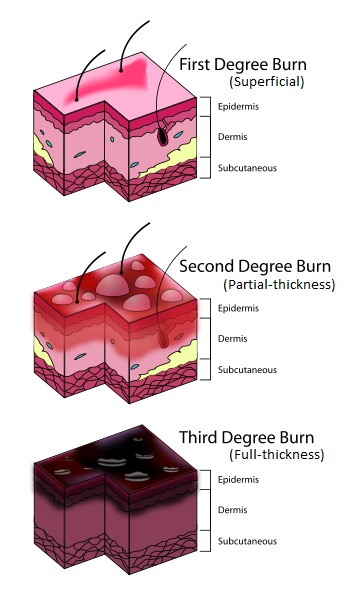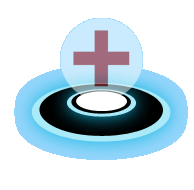







|
|
The human body has the ability to stay at a constant temperature.
When it's hot, we perspire and when it's cold, our body will burn calories to create heat.
Despite all the temperature changes, it is very important that our core temperature is at 98.6 degrees (or close to it).
If our body temperature gets too cold or too hot, we can find ourselves in life-threatening situations.
|
Burns
Burns can damage the top layer of skin or the skin and layers of fat, muscle, and bone beneath.
They are classified by their depth; the deeper the burn, the more severe it is.
The three classifications are superficial, partial-thickness, and full-thickness.

Superficial (first degree)
The burn involves the top layer of skin.
The skin may be red, dry, and painful.
Swelling is possible.
Treatment:
- Run cool water over the burn area and keep it there until there is little or no pain.
If no water is available, apply a dry dressing.
- Apply a moist dressing and bandage loosely.
Partial-thickness (second degree)
The burn involves the top layers of the skin.
The skin may be red, painful, and blistered.
Swelling will occur.
Treatment:
- Do not break the blisters.
- Run cool water over the burn area and keep it there until the pain lessens.
- Apply a moist dressing and bandage loosely.
- Do not apply any creams, ointments, or sprays.
Full-thickness (third degree)
All layers of skin and some or all the underlying structures (fat, muscles, bones, and nerves) may be destroyed.
The skin may appear brown or black (charred) with the tissue sometimes appearing white.
Can be extremely painful or painless (nerve endings may be destroyed by the burn).
Treatment:
- Do not remove any clothing as it may stick to the flesh.
Do not apply any creams, ointments, or sprays.
- Transport the person to the hospital.
Medical assistance is required for healing.
|
Frostbite
A cold-related emergency.
Frostbite is the freezing of body parts exposed to the cold.
The severity of the freezing is dependent upon the air temperature, length of exposure, and the wind.
Severe frostbite can result in the loss of fingers, hands, arms, toes, feet, and legs.
Signs of frostbite include the lack of feeling in the affected area, swelling, discolored skin (flushed, yellow, white, or blue).
In serious cases, blisters may form and the affected area may turn black.
Treatment:
- Call 911 or the local emergency number.
- Remove wet clothing and jewelry.
Transport the person away from the area.
- Do not rub or massage the frostbitten area.
This will cause further damage to the tissues.
- If there is a chance that the area may refreeze, do not attempt to warm the area.
- For minor frostbite, rewarm the affect area using skin-to-skin contact (a warm hand).
For a more serious injury, gently soak the affected area in warm water until normal color returns (20 to 30 minutes).
Loosely bandage the area with dry, sterile dressings.
Use cotton or gauze to separate frostbitten fingers or toes.
Do not break any blisters.
|
Heat Exhaustion
A heat-related emergency.
Heat exhaustion occurs due to overexposed to heat, and loss of fluids and electrolytes.
Signs of heat exhaustion include cool, moist, plate, ashen or flushed skin, headache, nausea, dizziness, weakness, and exhaustion.
Treatment:
- Move the victim out of the heat and into a cooler environment.
- Loosen or remove as much clothing as possible and apply cool, wet cloths.
- If the person is conscious, give them small amounts of cool fluid.
Do not let them drink too fast.
- If the person's condition does not improve, call 911 or the local emergency number.
|
Heat Stroke
A heat-related emergency.
Heat stroke is the least common of heat-related illness but it is the most severe.
This occurs when people ignore the signs of heat exhaustion.
The body's system becomes overwhelmed by the heat and stops functioning properly.
This is a serious medical emergency.
Signs of heat stroke include extremely high body temperature, red skin, changes in consciousness, a rapid and weak pulse, shallow breathing, confusion, vomiting, and seizures.
Treatment:
- Call 911 or the local emergency number.
- Rapidly cool the body by immersing the person up to the neck in cold water or spray the person with cold water.
- Sponge the person with cold towels or cover their body with bags of ice.
|
Hypothermia
A cold-related emergency.
Hypothermia occurs when the entire body loses more heat than it can generate.
Some conditions that can lead to hypothermia include ingestion of substances that interfere with the body's ability to regulate temperature, medical conditions that impair circulation, and prolonged exposure to cold, wet and or windy conditions.
The person can die if proper care is not administered.
Signs of hypothermia include shivering, numbness, indifference, glassy stare, loss of unconsciousness.
Treatment:
- Call 911 or the local emergency number.
- Move the person to a warm location and make them comfortable.
- Remove wet clothing and dry the person.
- Warm the body gradually by wrapping the person in blankets; keep the head covered.
- In extreme cases, rescuers may need to strip down to their undergarments to warm the victim with their body heat.
If the person is conscious, give warm liquids that do not contain alcohol or caffeine.
- Monitor their condition.
|
|















